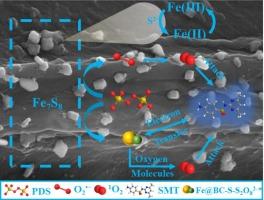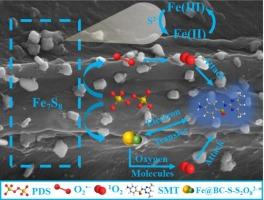双重非自由基途径增强PDS激活Fe@BC-S: Fe7S8介导1O2与电子转移的关系
IF 13.2
1区 工程技术
Q1 ENGINEERING, CHEMICAL
引用次数: 0
摘要
基于生物炭(BC)的催化剂已被广泛应用于过硫酸盐(PDS)的活化,是一种有效的水处理净化技术。然而,S 和 Fe 共掺杂的生物炭混合催化剂活化 PDS 的机理仍不明确。因此,本研究制备了外源掺杂的 Fe-S 生物炭(Fe@BC-S),用于活化 PDS 以降解磺胺甲基嘧啶(SMT),并在 Fe@BC-S 中形成了作为主要活性中心的 Fe7S8 位点。Fe@BC-S/PDS体系在50分钟内的磺胺甲基嘧啶降解效率(95.3%)远高于Fe@BC/PDS体系(62.5%)。研究发现,在更高效的 PDS 活化和 SMT 降解过程中,1O2 和电子转移的双重非自由基途径占主导地位。活化过程的具体机制可以确定为(i) 通过稳态浓度为 5.66 × 10-13 M 的 Fe(II)/Fe(III) 氧化还原循环连续生成 1O2。而 1O2 不仅来自 PDS → O2--→ 1O2 的反应过程,还来自亚稳定络合物中氧分子的氧化过程;(ii) S 的掺杂促进了电子传递能力,使 Fe@BC-S 与 PDS 之间通过外球相互作用形成亚稳定络合物,其中 Fe7S8 作为电子中间体介导了从污染物到 PDS 的电子传递过程。此外,1O2 和电子转移的双重非自由基途径选择性地攻击了 SMT 的富电子位点。此外,Fe@BC-S 还具有较高的环境适应性和稳定性。这项研究提出了一种生物炭改性的新策略,并为通过非radical途径增强水质净化提供了新的见解。本文章由计算机程序翻译,如有差异,请以英文原文为准。


Dual nonradical pathways in enhanced PDS activation by Fe@BC-S: Fe7S8 mediated the relationship between 1O2 and electron transfer
Biochar (BC)-based catalysts have been widely utilized in the activation of peroxydisulfate (PDS), representing an effective water treatment technique for decontamination purposes. However, the mechanisms of PDS activation by S and Fe co-doped biochar hybrid catalysts were still ambiguous. Therefore, Fe-S biochar by exogenous doping (Fe@BC-S) was prepared to activate PDS for sulfamethazine (SMT) degradation, and Fe7S8 sites were formed in Fe@BC-S acting as the main active center. The SMT degradation efficiency within 50 min in Fe@BC-S/PDS system (95.3 %) was much higher than that in Fe@BC/PDS system (62.5 %). It was found that the dual nonradical pathways by 1O2 and electron transfer dominated in the more efficient PDS activation and SMT degradation. The detailed mechanisms in the activation process could be determined to: (i) Successive 1O2 generation mediated via Fe(II)/Fe(III) redox cycle with a steady-state concentration of 5.66 × 10-13 M. And the 1O2 was derived from not only reaction process of PDS → O2·-→ 1O2, but also the oxidation of the oxygen molecules in the sub-stable complexes; (ii) The doping of S promoted the electrons transfer capability, enabling the formation of sub-stable complexes between Fe@BC-S and PDS through outer-sphere interactions, with Fe7S8 acting as an electron intermediate mediating the electron transfer process from the pollutants to PDS. Further, the dual nonradical pathways by 1O2 and electron transfer selectively attacked the electron-rich sites of SMT. In addition, Fe@BC-S exhibited high environmental adaptability and stability. This work suggested a new strategy for biochar modification and provided new insights into the enhanced water decontamination by nonradical pathways.
求助全文
通过发布文献求助,成功后即可免费获取论文全文。
去求助
来源期刊

Chemical Engineering Journal
工程技术-工程:化工
CiteScore
21.70
自引率
9.30%
发文量
6781
审稿时长
2.4 months
期刊介绍:
The Chemical Engineering Journal is an international research journal that invites contributions of original and novel fundamental research. It aims to provide an international platform for presenting original fundamental research, interpretative reviews, and discussions on new developments in chemical engineering. The journal welcomes papers that describe novel theory and its practical application, as well as those that demonstrate the transfer of techniques from other disciplines. It also welcomes reports on carefully conducted experimental work that is soundly interpreted. The main focus of the journal is on original and rigorous research results that have broad significance. The Catalysis section within the Chemical Engineering Journal focuses specifically on Experimental and Theoretical studies in the fields of heterogeneous catalysis, molecular catalysis, and biocatalysis. These studies have industrial impact on various sectors such as chemicals, energy, materials, foods, healthcare, and environmental protection.
 求助内容:
求助内容: 应助结果提醒方式:
应助结果提醒方式:


